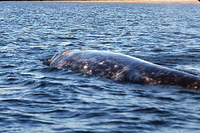Regulating the Whale Watching Industry

B.C. marine mammal enthusiasts are eagerly awaiting the federal government's decision as to whether they intend to go ahead with regulations governing the whale watching industry on the wet coast of Canada. Fisheries and Oceans Canada announced its intention of doing so in 2003, going so far as to seek public comment on a draft set of regulations. There is no word as to whether the current minority conservative government in Ottawa plans to take this dossier a step further and actually introduce legislation on the subject.
Aside from some rather weak regulations prohibiting harrassment of marine mammals, and a set of voluntary whale watching guidelines which the courts have used as a yardstick for determining whether harrassment has actually ocurred, the lucrative whale watching fleet is virtually ungoverned. This is in spite of the fact that the southern resident killer whales, which are the principal target of the industry, are officially listed as endangered on both sides of the Canada-U.S. border, in the Georgia Basin/Puget Sound area. Scientists have determined that the orcas are subject to threats from a number of sources, including contaminated habitat, dwindling food supply, noise pollution, and interference from the whale watching fleet and pleasure craft, which on a good summer day can number in excess of one hundred vessels. The guidelines are intended essentially to keep the boats a safe distance from the whales, while allowing the public to enjoy a wildlife experience for which they often pay top dollar.
The guidleines are by and large respected, at least by the commercial whale watching fleet, although such outlawed practices as getting in the path of the whales are extremely common. The whale watching business is highly competitive, and the vessel operators are under much pressure from clients to get closer and closer to the whales, and to get as close up as other boats. The result is that the guides often resort to a practice called 'leapfrogging', which brings them from a position alongside or behind the whales to one up in front of them. Nevertheless,it is the flotilla of pleasure craft that is most often guilty of infractions, sometimes out of ignorance, no doubt, but other times because there is little fear of sanction. Meanwhile, the Marine Mammal Monitoring Group ( M3 ) from Canada, and its American counterpart, Soundwatch from Friday Harbour on San Juan Island, try to keep an eye on what is going on and educate boaters, but they have no real powers of enforcement.
What is really lacking, and desperately needed, is control on the numbers, types and size of the fleet out on the water of Haro Strait at any given time. One whale expert has suggested a type of quota for the noise level, for instance, although it is difficult to see how this could be effectively enforced. A more likely control would be to place limits on the horsepower of the engines of the vessels involved, or perhaps the decibel level emanating from them underwater. Restrictions on the numbers of zodiacs tracking the whales, and/or the size of the vessels, are no doubt also being contemplated, as these types of suggestions were put forward during the course of the consultations. One theory has it that having a smaller number of large vessels capable of accommodating large numbers of whale watchers might have less of an overall impact on the whales than a large number of noisy, smaller, faster craft such as the zodiacs. At any given time on a lovely summer day there might be upwards of 18 to 24 zodiacs in the vicinity of the whales. When one considers that the orcas can be basically surrounded by a fleet this large from morning to night between May and October, the potential negative impact on these creatures is not hard to imagine. For this same reason, refuges, where the whales can go to excape the noise, the pollution, and the general congestion are also no doubt being considered.
In short, it would appear that something is going to have to be done to protect this endangered species from a largely unregulated business activity in the waters around Haro Strait in particular. What form that regulation might take is anyone's guess, but one can assume that there will be beefed up monitoring, control or enforcement, even if only to apply the existing regulations prohibiting harassment. The bottom line is that while self-enforcement has its plusess and minuses, it is probably insufficient to protect the southern resident killer whales from undue interference. Thus, stay tuned to this blog for updates as to the federal government's plans, as they are announced, possibly in the months to come.

0 Comments:
Post a Comment
<< Home